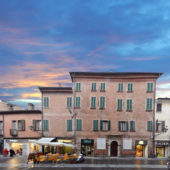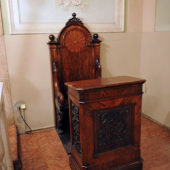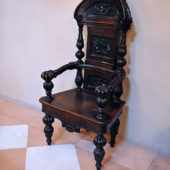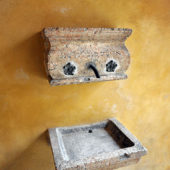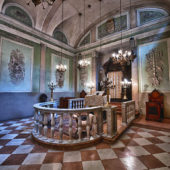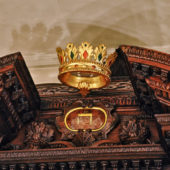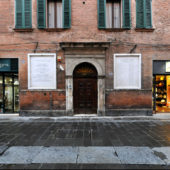Being the larger of Ferrara’s three synagogues, the Tedesco (German) is used for High Holiday services and other special holidays and events.
Founded in 1603, the synagogue continues to follow the German rite. Over the centuries the prayer room has undergone numerous restoration projects, particularly after WWII and the devastation caused by the Fascists on September 21st, 1941. The elegant rectangular prayer room features ivory walls decorated by stucco artist Gaetano Davio and a stunning vaulted ceiling. Five tall rectangular windows capped with semicircular windows adorn the right wall. Their number is symbolic of the number of books in the Torah. High up on the entrance wall is a grill, which hides the women’s gallery. This is no longer in use, but is part of the museum tour. An inscription just below the grill in Hebrew reads, “Law and Justice always reside in your Lord.” There are several memorial tablets on the wall commemorating dates of restoration projects (1760, 1827, 1859 and 1905). Biblical verses are inscribed in Hebrew from the Psalms along the upper perimeter of the hall. They are used as a decorative element, as it is contrary to The Ten Commandments to make graven images of God’s creation. The 17th century Aron Kodesh sits on a platform behind a white marble balustrade, and it is magnificently carved of wood. It is flanked by two, beautifully carved wooden chairs. The tivah (reader’s desk), is simply carved of wood and sits off to the left of the bimah. An eternal lights drops down over the bimah, and brass candelabras sit on the platform. Several elegant, multi-armed brass chandeliers drop down from the ceiling throughout the prayer room.
Upon exiting Scola Tedesca and descending the staircase, one notes two memorial tablets in Italian on the first landing, one of which was dedicated to a benefactor of the community in 1917. Underneath these tablets are two small collection boxes. From this landing is the entrance of the women’s gallery, as well as several displays of prayer books, fascias and mantles for covering the Torah, placed here by the museum. In front of this is the entrance to the museum. Ascending a staircase and crossing through a glass gallery, we arrive in the area that the ancient Rabbinical Tribunal reconstructed after the devastation of WWII. The Tribunal operated in Ferrara until the end of the 1800s and it was their responsibility to settle economic and matrimonial disputes. It is likely that they met in one of the two rooms now occupied by the museum. Ferrara is the only city in the Emilia-Romagna region of Italy to boast an uninterrupted Jewish presence from the middle ages to the present. The first definitive record of Jews in the city is a notarized document referencing Sabatinus Judeus, together with several other documents, all of which date back to 1227. According to other archives found, seventeen Jewish families lived in the Via Boccacanale area of Ferrara in 1310. Further documents reveal a continued Jewish presence in the city since that time. After 1400, there is evidence that Jews in Ferrara began to live in an area later selected for the ghetto. However, prior to that time, the Jewish community flourished under the government of the Este family. They were allowed to practice a variety of commercial and professional occupations – not just money lending, as was common in many parts of Italy.
At the end of the 15th century and the first half of the 16th century, Ferrara welcomed Sephardic Jews (who were expelled from Spain and Portugal in 1492), and in approximately 1532, groups of Ashkenazi Jews (of German origin) were also accepted into the city. As a result, the Jewish community increased significantly. Out of a population of 30,000 people, 2,000 of them were Jews. Ferrara became a melting pot for different Jewish cultures. There were many cultured and important Jewish figures making their home in Ferrara. When Duke Alfonso d’Este died in 1597, without having produced any male heirs, conditions took a turn for a worse for the Jewish community. Ferrara was annexed by the Papacy and Duke Cesare d’Este transferred his court to Modena. Therefore, many Jews left Ferrara. Those who stayed saw their freedoms and rights diminished or denied.
In 1627 a ghetto was forced upon the Jewish community, followed by a period of persecution and humiliation. The community found solace in studying their sacred texts. During their time in the ghetto, many rabbis became leading experts in their fields of study. The Jews were released from the ghetto in 1859, due to the annexation of Ferrara to the Kingdom of Italy. After the destruction of the ghetto barriers, the following decades saw the Jews of Ferrara experimenting with complete integration into the social fabric of the city. In 1938 racial laws were instituted. This was followed by Nazi and Fascist deportations, which devastated the city. 96 Jews were deported to concentration camps and not one returned. Today, there are approximately 80 members of Ferrara’s Jewish community.
Ferrara boasts three synagogues, which are actually in the same building in which they were originally housed in, since 1485. Two of these synagogues continue to be in use today. There are different synagogues to provide worship according to the different rites. The façade of the building is identical to the surrounding buildings, which was common in order to escape persecution. Post WWII, memorial tablets were put up, flanking the front door, listing the names of the Jews from Ferrara who were deported to concentration camps between 1943 and 1945. Inside, the structure is rather like a labyrinth, which although recently renovated, reveals the combination of different architectural styles added over the years, creating an intriguing, eclectic atmosphere. In the foyer, a sweeping staircase leads to an imposing safe in wood, decorated with black studs. This most likely dates back to the 17th century. Offices and the rabbi’s home also inhabit the first floor, together with the Fanese-rite (Scola Fanese) synagogue.

